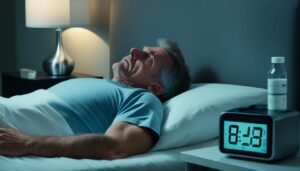Many adults struggle with back pain.1 Over 80% will feel lower back discomfort during their lives.1 This piece will offer advice from spine health experts. It includes tips for dealing with chronic back pain and how to manage herniated discs and sciatica. We’ll talk about options like nonsurgical methods, injections, and what role surgery plays. Also, you’ll read about using over-the-counter medicine, hot and cold therapy, and specific exercises for relief.
Key Takeaways
- Chronic back pain lasts three months or more.2
- Arthritis, spinal stenosis, and disc issues are main causes.2
- Physical therapy, acupuncture, and massage can help a lot.2
- Doctors don’t usually start with opioids for this pain.2
- Surgery is the final choice after other treatments.2
Understanding Chronic Back Pain
Chronic back pain often comes with age or after an injury.3 Causes include spine arthritis, spinal stenosis, and disc issues like herniated or bulging discs. Myofascial pain syndrome is also a common reason.2
Common Causes of Chronic Back Pain
Back pain becomes chronic if it sticks around for three months or more.2 Spine arthritis, spinal stenosis, and disc problems are frequent culprits. So is myofascial pain syndrome.2
When to Seek a Second Opinion
Diagnosing chronic back pain can be tough. If your current doctor has tried everything and you’re still in the dark, it’s wise to see a back pain specialist for another view.
| Chronic Back Pain Causes | Description |
|---|---|
| Arthritis of the Spine | Degenerative changes in the spinal joints and discs, leading to inflammation and pain. |
| Spinal Stenosis | Narrowing of the spinal canal, which can put pressure on the nerves and cause pain, numbness, and weakness. |
| Herniated or Bulging Discs | Damaged intervertebral discs that can irritate nearby nerves and cause radiating pain. |
| Myofascial Pain Syndrome | A chronic pain condition involving sensitivity and tightness in the muscles and connective tissue. |
Nonsurgical Treatments for Chronic Back Pain
Chronic back pain can benefit a lot from exercise. Physical therapy proves very helpful. The exercises you do should match your pain, condition, and comfort. This makes them more effective.2 It’s crucial to stick to these exercises at home. They help keep your back strong and stable.2
Physical Therapy and Home Exercise Program
Mindfulness, meditation, yoga, and tai chi work well for coping with the mental side of chronic back pain.2 Changing your diet and lifestyle – like staying at a good weight and not smoking – can also make a big difference in your pain.2
Mindfulness and Meditation
Diet changes and lifestyle tweaks help a lot too. Being fit, not smoking, and taking it easy with your activities can ease chronic back pain.245
Diet Change
Lifestyle adjustments play a big role in managing chronic back pain. Staying fit, ditching cigarettes, and being mindful of how you move can help a ton.245
Lifestyle Modifications
| Nonsurgical Treatments | Effectiveness |
|---|---|
| Physical Therapy | Highly effective for chronic back pain when tailored to individual needs2 |
| Mindfulness and Meditation | Helpful for managing the emotional and psychological aspects of chronic back pain2 |
| Dietary Changes | Can significantly improve chronic back pain by reducing inflammation245 |
| Lifestyle Modifications | Maintaining a healthy weight, quitting smoking, and pacing activities can improve chronic back pain245 |

Injection-based Treatments
Some procedures like trigger point injections and epidural steroid injections can help with chronic back pain.6 Doctors use these when they know the pain’s cause. If the treatment doesn’t work, it helps eliminate the wrong causes.6 Such injections can ease pain for a while. But remember, they’re not long-term fixes. They should be part of a bigger plan that includes being active and doing therapy or exercises at home.6
For example, epidural glucocorticoid injections can start helping in a few days. The pain relief can last from a few days to a few months.7 Joint injections and facet joint blocks might give relief for weeks or months in some cases.7 Before opting for surgery, spine injections are tried.8 Often, they’re enough to avoid an operation. But if they don’t ease the pain, surgery might be necessary.8 Of course, these injections do come with risks like infection or nerve damage.8 So, it’s important for doctors and patients to carefully consider their options.
Alternative Therapies
Are you suffering from constant back pain? There are alternative options to consider, like acupuncture and massage. These methods are known to help without surgery. Plus, they are safe, so including them in your pain management plan is a good idea.
Acupuncture can be very effective for back pain, according to studies.4 Biofeedback therapy, which teaches people to control how their body responds, also works well. It reduces both pain and muscle tension.
Trying out mindfulness or yoga could also ease your lower back pain.4 After twelve weeks of yoga, patients needed less pain medicine. This shows that adding exercise and mental relaxation can help a lot.
Before trying these therapies, talk to your doctor. They can help you choose the best option for you. By looking at different non-surgical treatments, you might find just what you need to feel better.
| Alternative Therapy | Potential Benefits for Chronic Back Pain |
|---|---|
| Acupuncture | May be an effective therapy for certain types of back pain4 |
| Massage | People who had 1 hour of massage each week saw big improvements. They had less pain, did more, and spent less time in bed9 |
| Biofeedback Therapy | Helps lower back pain and muscle tension4 |
| Laser Therapy | Could help with the pain of lower back issues |
| Electrical Nerve Stimulation | Offers some pain relief for lower back pain, but the evidence is not strong9 |
Combining different therapies can greatly benefit people with lower back pain. It’s key to work with your healthcare team to find the right approach for you.
Pharmacologic Treatments
Doctors use various medications to help with chronic back pain. These include10 types like anti-inflammatories and muscle relaxants. Nerve pain meds10 and even antidepressants10 can be prescribed. Yet, all medicines can bring on side effects. Patients should discuss with their doctor to find the best medication. They do this based on what might be causing the pain.
Opioid Medications and Chronic Back Pain
Opioids are not the first choice for treating long-term back pain. Using them can lead to needing more over time, getting physically attached, and forming habits11. Doctors will only turn to opioids after trying other kinds of medicine first without success.


| Medication Class | Acute LBP Findings | Chronic LBP Findings |
|---|---|---|
| NSAIDs | Moderate-certain evidence for reducing pain intensity (MD -7.29) and disability (MD -2.02)11 | No high- or moderate-certainty evidence for large or medium effect on pain intensity compared to placebo11 |
| Muscle Relaxants | Moderate certainty of a small between-group difference for pain relief (RR 0.58) and improving physical function (RR 0.55)11 | No high- or moderate-certainty evidence for large or medium effect on pain intensity compared to placebo11 |
| Opioids | No high- or moderate-certainty evidence for large or medium effect on pain intensity compared to placebo11 | High certainty evidence for reducing pain intensity (MD -8.00), moderate certainty for reducing disability (SMD -0.26)11 |
| Tapentadol | No data available | Moderate-certainty evidence in reducing pain intensity (MD -8.00)11 |
When is Surgery Recommended?
Back surgery might be an option if you have chronic back pain. However, it’s the most invasive choice with high risks. It should only be considered when other treatments like physical therapy and medications have not worked.12 These conservative options can help about 75% of people with back pain.12
“Red Flag” Symptoms
If you notice sudden or worsening “red flag” symptoms like new bowel issues or limb weakness, it could be a sign of something serious.12 Conditions such as cauda equina syndrome may require quick surgery.12
Considering Surgery as a Last Resort
Back surgery might help some people but doesn’t always completely stop the pain.13 Most surgeons, like Dr. Kilpatrick, start with milder treatments before considering surgery.12 It should be the last choice, used when other options can’t improve the pain or how you live and work.12
Please, think about the risks and benefits of surgery. It’s smart to get a second opinion from another spine specialist.13 Remember, most back pain cases don’t need surgery right away.12
Over-the-Counter Pain Relievers
Over-the-counter pain medications help with mild injuries and strains. They include nonsteroidal anti-inflammatory drugs (NSAIDs) and acetaminophen. Acetaminophen, like Tylenol, is often the first choice. It has fewer side effects than other options. The daily limit for acetaminophen is 3 grams. This keeps your liver safe.14 NSAIDs, such as ibuprofen, can also be used. They’re good for easing back pain and reducing swelling. You don’t need a doctor’s note to buy them.14
Pain relief products like creams and ointments work well for lower back pain. They’re good for occasional use. But, if your back pain comes back often, talk to your doctor. They can help you find a plan that’s right for you.14 Be careful with too much NSAIDs or acetaminophen. Using a lot or using them for a long time can hurt your stomach, cause ulcers, or damage your kidneys and liver.14
15 Acetaminophen, Ibuprofen, and Naproxen Sodium can all help ease back pain.15 If the pain keeps up for more than 10 days with these, see a doctor. They might offer you something stronger.15
| Medication | Effectiveness | Potential Side Effects |
|---|---|---|
| Acetaminophen (Tylenol) | First-line over-the-counter pain reliever | Fewer side effects compared to other medicines; Liver damage if taken in high doses |
| NSAIDs (Ibuprofen, Naproxen) | Reduce back pain and swelling | Stomach pain, ulcers, kidney or liver damage if taken in high doses or long-term |
| Topical Pain Relievers | Provide temporary relief for lower back pain | Minimal side effects when used as directed |
OTC pain meds and topicals are great for now-and-then back pain. Just don’t use them every day for a long time. Always talk to a doctor for the best advice.14
Hot and Cold Therapy
Hot and cold temperatures work well to relieve lower back pain. Cold temperatures can lessen inflammation and reduce swelling16. Heat helps by relaxing the muscles16. You can use either cold or hot therapy for 20 minutes, a few times each day. Do this until your back starts feeling better.
Moist heat, from baths or hot packs, is usually more effective than dry heat.16 A study in 2021 showed that moist heat, like wraps, can help muscle pain faster than dry heat17.
In another 2021 study, researchers found that both hot and cold therapy can ease pain. Cold therapy works well for lessening bruising and swelling, while heat helps with muscle spasm relief.17 Versus Arthritis recommends switching between hot and cold to ease back pain.17
Cold therapy is especially good for back pain from muscle injuries like strains or sprains. It cuts down on bruising, swelling, and inflammation.17 A 2020 study discovered that a heated device pulsing at 45°C (113°F) provided better and longer pain relief than constant heat at 37°C (97°F).17
| Hot Therapy | Cold Therapy |
|---|---|
About 30–40% of adults deal with back pain, and it’s more common as people get older.17
Gentle Exercise for Back Pain
Rest is key to healing, but being too still is bad.18 Activities like walking, swimming, and light stretching can help a lot.18 They boost healing and blood flow. Movement also keeps your spine’s muscles from getting too tight or weak. This could make back pain worse.18 Focus on gentle workouts that make your core stronger and your body more flexible. This can ease and stop back pain.18
18 You can repeat the easy exercises several times for better results. Start slow and add more as you get comfortable.18 If you have back pain a lot or recently, it’s smart to talk to a physical therapist or a doctor. They can guide you on safe exercises.18
19 Acute back pain is common and goes away in a few days or weeks. Chronic back pain lasts beyond 12 weeks and has similar origins as acute pain.19 Exercises that make your glutes and abs stronger can help your back a lot. That’s the goal of glute bridges.19 Begin with 5, then work your way up to 30 of them.19
19 Start with just 5 of the lower back flexibility exercise and aim for 30 over time.19 Adding the Cat and Cow Stretch to your routine can also be very beneficial.19 Aim for 3 to 5 repetitions of the Seated Lower Back Rotational exercise on each side. Do it twice daily.19
18 Repeat each stretch 2 to 3 times. Begin with 5 of the lower back exercise and increase to 30.18 Start the bridge with 5 and add by 5s up to 30. For the Cat stretch, aim for 3 to 5 reps, done twice daily.18 The shoulder blade squeeze should be done 3 to 5 times, also twice a day.18
Back Pain Relief Techniques
Getting help from a physical therapist can really make a difference if your back hurts for more than a month or two.1 They use special treatments like electrical stimulation, ultrasound, and heat. This helps you move and bend better. They also show you exercises to keep up at home to get better.1
Find a Physical Therapist
Things like moving your spine a lot and getting massages can also help if your back always aches.1,20 It’s been proven that getting stronger, more flexible, and having better stamina can reduce back pain.20 Having a massage every week for ten weeks can make your pain and how well you move feel better. And this good feeling can last up to six months.20
Try Manipulation or Massage
Some research says that learning how to relax and be mindful can make your pain and feelings of stress better.1 If you have a hard time with stress, you are more likely to have a sore back.1 Learning how to think differently with therapy can also help a lot with back pain, even in the long run.20
Calm Your Mind
Back Pain
It’s key to stay active even with back pain for a good recovery.21 Activities like walking, swimming, and yoga make the body stronger and more flexible. These also reduce pain.22
Keep Moving, Keep Stretching
Good posture is crucial for managing back pain. Sit and stand straight.22 Ice packs and heating pads are great for quick relief.22
Maintain Good Posture
Apply Ice and Heat
Keeping a healthy weight and not smoking are big steps to lessen back pain.22 The right weight makes it easier on your back. Smoking can hurt back muscles even more.22
Maintain a Healthy Weight
Quit Smoking
Placing a rolled-up towel under your pelvis helps lower back tension.22
Use a Towel for Support
Conclusion
Dealing with chronic back pain is complex but manageable. It involves many treatments, from therapy to surgery.23 Nearly 8 out of 10 people face back pain at some point, and if it lasts over three months, it’s called chronic.
Working closely with doctors helps people create plans for their specific pain.24 It’s important to explore treatment options and be patient.23 Back pain can usually get better on its own, but severe pain lasting more than three days needs a doctor’s check.2324 If pain won’t go away with home treatments, seeing a doctor is wise. In some cases, surgery or quick medical help might be needed.
Using a mix of treatments helps combat chronic pain and improve life.24 Lifestyle changes, like exercise and keeping a healthy weight, can prevent more back pain. And, simple at-home steps such as cold packs and light painkillers can ease pain.
FAQ
What are the common causes of chronic back pain?
When should I seek a second opinion for my chronic back pain?
How can physical therapy and home exercises help manage chronic back pain?
What role do injection-based treatments play in managing chronic back pain?
What alternative therapies can be helpful for chronic back pain?
How can medications be used to manage chronic back pain?
When is surgery recommended for chronic back pain?
How can over-the-counter pain medications help with back pain?
How can hot and cold therapy help with back pain?
What types of gentle exercise can help with back pain?
How can physical therapists and other techniques help with chronic back pain?
What lifestyle changes can help manage and prevent back pain?
Source Links
- https://www.webmd.com/back-pain/what-helps-with-lower-back-pain
- https://www.hopkinsmedicine.org/health/conditions-and-diseases/back-pain/7-ways-to-treat-chronic-back-pain-without-surgery
- https://www.ninds.nih.gov/health-information/disorders/back-pain
- https://utswmed.org/medblog/alternative-back-pain-treatment/
- https://www.medicalnewstoday.com/articles/325609
- https://www.webmd.com/back-pain/back-pain-injection-treatments
- https://www.arthritis.org/health-wellness/healthy-living/managing-pain/pain-relief-solutions/injections-and-implants-for-back-pain
- https://www.dukehealth.org/blog/back-and-neck-pain-spine-injections-offer-relief-without-surgery
- https://www.webmd.com/back-pain/features/alternative-approaches-to-low-back-pain
- https://www.ncbi.nlm.nih.gov/pmc/articles/PMC8088811/
- https://pubmed.ncbi.nlm.nih.gov/37014979/
- https://www.novanthealth.org/healthy-headlines/when-is-back-surgery-necessary
- https://www.mayoclinic.org/diseases-conditions/back-pain/in-depth/back-surgery/art-20048274
- https://medlineplus.gov/ency/article/007486.htm
- https://www.webmd.com/back-pain/home-relief-for-low-back-pain
- https://www.spine.md/insights/ice-or-heat-for-lower-back-pain
- https://www.medicalnewstoday.com/articles/ice-or-heat-for-back-pain
- https://www.mayoclinic.org/healthy-lifestyle/adult-health/in-depth/back-pain/art-20546859
- https://www.webmd.com/back-pain/exercises-lower-back-pain
- https://www.webmd.com/pain-management/ss/slideshow-relieving-back-pain
- https://www.niams.nih.gov/health-topics/back-pain
- https://www.mayoclinic.org/diseases-conditions/back-pain/symptoms-causes/syc-20369906
- https://medlineplus.gov/backpain.html
- https://www.gleneagles.com.sg/health-plus/article/back-pain-emergency




